Flow of the year
The Barcelona year is marked by its festivals and holidays many of which will be new and many of which are very locally based traditions.
 The three first months of the year are typically relatively quiet. We haven't spent New Year here so can't say how strongly that is celebrated, but religion plays a great part in the festival days and Epiphany (6th Jan) is set aside for a holiday and is traditionally the day the children receive their Christmas presents from the Three Kings (Los Tres Reyes). There is a parade of the Three Kings on the 5th January.
The three first months of the year are typically relatively quiet. We haven't spent New Year here so can't say how strongly that is celebrated, but religion plays a great part in the festival days and Epiphany (6th Jan) is set aside for a holiday and is traditionally the day the children receive their Christmas presents from the Three Kings (Los Tres Reyes). There is a parade of the Three Kings on the 5th January.
For the remainder of January and February things are typically colder and there may be some snow, particularly if you live away from the coast. In the mountains the ski resorts are typically hoping for a lot of snow (2007 was too hot and a disaster for the resorts). The city is typically quiet and you will need to wrap up a bit more when out and about and probably even turn on the heating. Walking in the hills and mountains is more common at this time of year.
In February is Valentine's day (14th) and though there are signs of it around, it is not the great event you find in the UK or US. In general the Spanish don't send or spend money on greetings cards. The romance of St Valentines day is typically seen at St Jordi's day (see below). In the city St Eulalia, a saint from the city, is celebrated between the 8th and 10th February. February/March is normally strawberry season, the first locally grown strawberries entering the shops mid-Feb - a vivid demonstration of the difference in seasons compared to the UK.
In March (or whenever Lent starts) comes 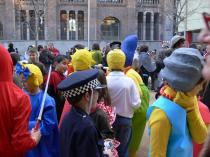 the start of Lent which means Carnaval (Carnesaltres) - the Spanish Mardi Gras. Carnaval was surpressed in Spain under Franco and there is a sense of the country rediscovering carnaval in a big way. It officially begins on Dijous Gras (Fat Thursday in Catalan) and then lasts 5 days over the weekend until Dimercres de Cendre (Ash Wednesday). Parties and fiestas are held at schools with a lot of dressing up and there are floats, parades, giants (gigantes) in the city. You will also find shop keepers and market stall holders dressed up. There is a very celebrated festival in Sitges, revelling in it's reputation as the gay capital of Spain.
the start of Lent which means Carnaval (Carnesaltres) - the Spanish Mardi Gras. Carnaval was surpressed in Spain under Franco and there is a sense of the country rediscovering carnaval in a big way. It officially begins on Dijous Gras (Fat Thursday in Catalan) and then lasts 5 days over the weekend until Dimercres de Cendre (Ash Wednesday). Parties and fiestas are held at schools with a lot of dressing up and there are floats, parades, giants (gigantes) in the city. You will also find shop keepers and market stall holders dressed up. There is a very celebrated festival in Sitges, revelling in it's reputation as the gay capital of Spain.
Easter itself is celebrated with Easter cakes rather than Easter eggs (the level of commercialism and chocolate associated with festivals is thankfully far less than in the UK). Easter week itself is usually a holiday and many people take Easter breaks. The weather is also usually turning at this point and the first sunbathers start heading for the beach with the rather strange site of topless sunseekers next to beach visitors still wearing their winter coats as normally Catalonians need it to be really hot to start shedding clothes. The first groups of tourists start coming around Easter week and the tide grows steadily from now until the end of summer.
April 23rd is St George's (St Jordi's) day. This is an important festival for Barcelona and Catalunya as St George is their patron saint as it is England's (the flag of Saint George is on the city arms). As the date is the birthdate of Shakespere and Cervantes this has developed into the most romantic day in the year. Women buy men a book and men buy their beloved a rose - a habit that would be well worth exporting to England.
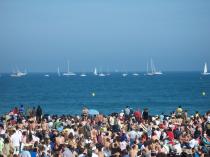 May sees days warming up and is an especially pleasant time to visit as plants are growing and the city seems to come into bloom. There are normally a large number of sporting events taking place around this time. In 2006 there was the Red Bull air race over the beaches with a million people watching (it was actually duller than it sounds).
May sees days warming up and is an especially pleasant time to visit as plants are growing and the city seems to come into bloom. There are normally a large number of sporting events taking place around this time. In 2006 there was the Red Bull air race over the beaches with a million people watching (it was actually duller than it sounds).
June sees the official start of summer. The beaches get live guards and the official swimming season starts as the sea water is normally now about 20C (just be careful of jellyfish). In June, schools switch to their intensive day teaching only in the morning with children coming home in the afternoon. June also sees the first of the summer music festivals and, being the end of the school year, large numbers of school concerts and activities.
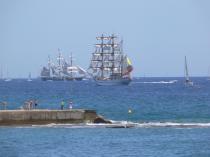 The school terms officially ends around the festival of St Joan (24th June). This is the big firework night for the city and bangers and fireworks will be heard in the city throughout June in the build up to the big event. Normally the festival of St Joan has lots of fireworks, street parties and lots and lots of noise. People (including children) dress up carrying a pitchfork onto which fireworks have been attached and run around chasing someone dressed up as the devil. It would give Health and Safety a heart attack.
The school terms officially ends around the festival of St Joan (24th June). This is the big firework night for the city and bangers and fireworks will be heard in the city throughout June in the build up to the big event. Normally the festival of St Joan has lots of fireworks, street parties and lots and lots of noise. People (including children) dress up carrying a pitchfork onto which fireworks have been attached and run around chasing someone dressed up as the devil. It would give Health and Safety a heart attack.
July is the start of the holidays. The school break lasts from the end of June to the start of September (around 12 weeks). July is often spent in the city with children at local casals (school holiday camps). The weather is hotter, air-conditioning is typically blasting away, the beaches are full and the city starts gearing up for it's holiday.
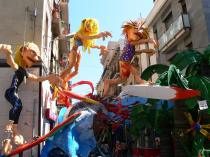 August is traditionally the month for leaving the city. In August people from Barcelona will either head to the mountains for the cool, or to the costas, or perhaps to some other area of Spain to visit family. Smaller shops will close down over August, there are no casals for the children and the city is largely for the tourists. There are some exceptions. Barrios such as Gracia start holding their local highly decorativeand imaginative festivals.
August is traditionally the month for leaving the city. In August people from Barcelona will either head to the mountains for the cool, or to the costas, or perhaps to some other area of Spain to visit family. Smaller shops will close down over August, there are no casals for the children and the city is largely for the tourists. There are some exceptions. Barrios such as Gracia start holding their local highly decorativeand imaginative festivals.
September and people drift back to the city. It's still hot and certainly pleasant enough to swim, but September normally sees the first of signs of rain and thunderstorms which wash the dust and grime of the city along the storm sewers and into the sea. The thunderstorms mark the sign of a city getting back to work. This is also Castellar season with competitions across Catalunyan towns as to which team can build the tallest Castellar or human town. This is very Catalan, with towers of up to 8 or 9 levels (a child on top) and dedicated castellar clubs who train extensively beforehand.
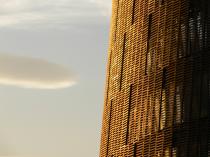 September also has two public holidays - the 11th Diada (yes the same day as 9-11) which marks the anniversary of the Spanish take over of Catalunya in 1714 (nearly 300 years) with the end of the siege of Barcelona. The same event is marked by a constant flame beside the cathedral in El Born. This is a day off, but largely political.
September also has two public holidays - the 11th Diada (yes the same day as 9-11) which marks the anniversary of the Spanish take over of Catalunya in 1714 (nearly 300 years) with the end of the siege of Barcelona. The same event is marked by a constant flame beside the cathedral in El Born. This is a day off, but largely political.
The second is the 24th of September - Merce - which is a Spanish holiday and is celebrated more as a festival with fireworks across the city and the Gigantes (giants) on display.
In October the temperature turns a little cooler and so is an excellent time to explore the city by foot. Halloween is big in the UK and US, but in Spain it is All Saint Day (1st November) that is the important festival, Also known as the Day of the Dead it is the time that people visit the cemetaries and pay homage to their ancestors. Halloween tends only to be popular among the ex-pats and those learning English.
In November thoughts turn towards Christmas. Mushrooms enter the supermarkets and castenyas (chestnuts) are eaten hots around the city. At school, the children take trips to the woods and hills around the city. On the palm trees lining the city roads, you get a harvest of date, much to the noisy enjoyment of the wild green parrots.
 Like much of Europe, St Nicholas's day (6th December) is a feast day. Traditional candies and sweets such as Turron (nougat in either a traditional hard form or a Spanish speciality softer form) are eaten and walnuts and dried fruit can be found in the shops.
Like much of Europe, St Nicholas's day (6th December) is a feast day. Traditional candies and sweets such as Turron (nougat in either a traditional hard form or a Spanish speciality softer form) are eaten and walnuts and dried fruit can be found in the shops.
At school carols and school concerts abound and around the city very large nativity scenes will be found, but city sponsored, but also in the foyers and lobbies of larger companies (look out for the figure dropping his trousers or doing a pooh in the scene - yes really).
Catalunyan tradition has the beating of a log (Cacatio) by children - normally decorated with twig legs, a face and a red scarf - with sufficient beating sweets are revealed and shared among the children.
Christmas trees are not a traditional part of a Spanish Christmas, but with the levels of commercialism are creeping in. Christmas still has all the toys and pressure to spend, but the day for giving children presents is more typically the 6th January. We have yet to have a full Christmas here, but Christmas Eve is very very quiet with almost no-one about.






 Living in Barcelona
Living in Barcelona